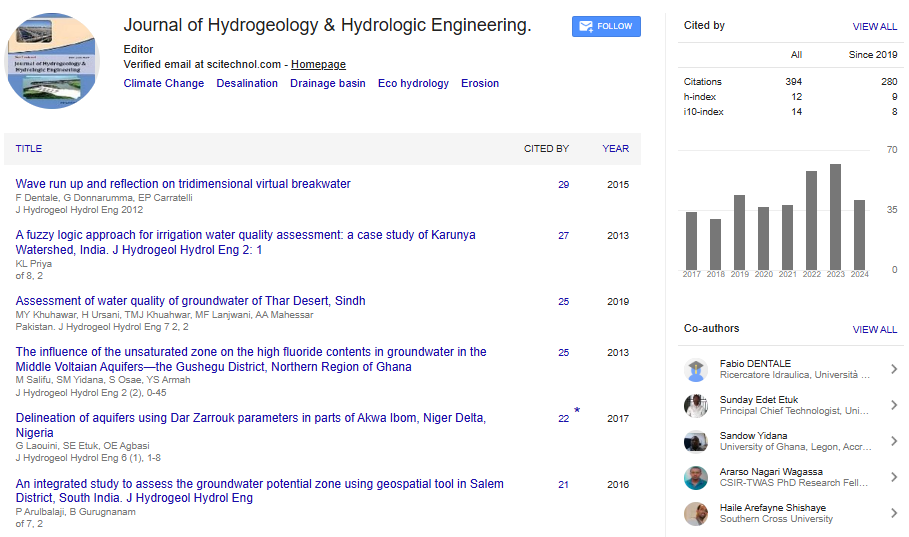Perspective, J Hydrogeol Hydrol Eng Vol: 13 Issue: 4
Erosion and Sedimentation Control: Strategies for Sustainable Land Management
Antonio Villar*
1Department of Environmental Science, University of Chinese Academy of Sciences, Chongqing, China
*Corresponding Author: Antonio Villar,
Department of Environmental Science,
University of Chinese Academy of Sciences, Chongqing, China
E-mail: villara234@gmail.com
Received date: 29 July, 2024, Manuscript No. JHHE-24-149245;
Editor assigned date: 31 July, 2024, PreQC No. JHHE-24-149245 (PQ);
Reviewed date: 14 August, 2024, QC No. JHHE-24-149245;
Revised date: 21 August, 2024, Manuscript No. JHHE-24-149245 (R);
Published date: 29 August, 2024, DOI: 10.4172/2325-9647.1000333
Citation: Villar A (2024) Erosion and Sedimentation Control: Strategies for Sustainable Land Management. J Hydrogeol Hydrol Eng 13:4.
Description
Erosion and sedimentation are natural processes that shape the Earth's surface, but human activities can significantly accelerate them, leading to environmental degradation and long-term damage to ecosystems. Erosion involves the detachment and transport of soil and rock by water, wind, or ice, while sedimentation is the process of these materials settling in new locations. Uncontrolled erosion can result in loss of fertile soil, water pollution and damage to aquatic habitats. Thus, effective erosion and sedimentation control measures are vital for sustainable land management and ecosystem preservation.
Erosion can be driven by several natural forces, such as rainfall, surface runoff and wind, but human activities often exacerbate these processes. Land development, construction, deforestation, agriculture and mining disturb the soil and vegetation cover, leaving areas vulnerable to erosion. When protective vegetation is removed, soil particles are easily washed or blown away. Without proper control, the displaced sediments can clog rivers, lakes and reservoirs, affecting water quality and aquatic ecosystems.
Agricultural practices such as overgrazing and improper plowing techniques can also lead to accelerated erosion. Similarly, construction activities that involve earth-moving equipment expose bare soil, increasing the risk of soil being washed away by rainfall. When soil particles reach waterways, they cause sedimentation, which leads to clogged drainage systems and sediment accumulation in water bodies. These processes reduce water capacity, increase the risk of flooding and degrade water quality.
The consequences of unchecked erosion and sedimentation are farreaching. One of the most significant impacts is the loss of topsoil, which is essential for agricultural productivity. The removal of this fertile layer reduces soil fertility, leading to lower crop yields and increased use of chemical fertilizers. In addition to agricultural damage, erosion also affects infrastructure. Roads, bridges and buildings can be undermined as the soil around them erodes, leading to structural instability and increased maintenance costs.
Sedimentation in water bodies can lead to the degradation of aquatic habitats, particularly for species that rely on clear water for spawning or feeding. The accumulation of sediments can also increase the turbidity of water, reducing sunlight penetration and disrupting photosynthesis for aquatic plants. Furthermore, sediment-laden water can cause problems in drinking water supplies, clogging filtration systems and increasing water treatment costs.
One of the simplest and most effective ways to prevent erosion is by maintaining or restoring vegetative cover on the land. Plants help anchor the soil, reduce the speed of water runoff and trap sediment before it reaches water bodies. Grasses, shrubs and trees are often used in reforestation and grass seeding programs to stabilize soil and reduce erosion. In agricultural settings, contour plowing and terracing are widely used to control water flow and reduce soil erosion. These methods involve creating furrows or terraces that follow the natural contour of the land, reducing the velocity of water runoff and encouraging water infiltration into the soil.
On construction sites, silt fences and sediment basins are commonly employed to control erosion and sedimentation. Silt fences act as barriers to trap sediment-laden runoff, while sediment basins allow sediments to settle out of the water before it is discharged into natural watercourses. Applying mulch or other ground covers is another effective method for controlling erosion on bare soil. Mulch helps protect the soil from the impact of rainfall, slows water runoff and retains moisture in the soil, promoting plant growth. Along rivers and streams, riparian buffers zones of vegetation can help filter out sediments and pollutants before they reach the water. These buffers also provide habitat for wildlife and enhance water quality by stabilizing stream banks.
Conclusion
Erosion and sedimentation control is essential for maintaining soil health, preserving water quality and protecting infrastructure. The use of natural and engineered solutions, such as vegetative cover, terracing and sediment basins, helps mitigate the negative impacts of soil displacement. By adopting sustainable practices in agriculture, construction and land development, erosion and sedimentation can be effectively controlled, promoting environmental sustainability and flexibility.
 Spanish
Spanish  Chinese
Chinese  Russian
Russian  German
German  French
French  Japanese
Japanese  Portuguese
Portuguese  Hindi
Hindi 
